Intel Atom D510: Pine Trail Boosts Performance, Cuts Power
by Anand Lal Shimpi on December 21, 2009 12:01 AM EST- Posted in
- CPUs
Meet the Board
We’ve got two Pine Trail articles for you today. I’m looking at the dual-core nettop version while Jarred is looking at the first Pine Trail netbook: ASUS’ EeePC 1005PE.
Intel sent me their first desktop Pine Trail motherboard: the D510MO(B). It’s a rather pedestrian looking mini-ITX design with a single 32-bit PCI slot (no PCIe) and a mini-PCIe socket on board.
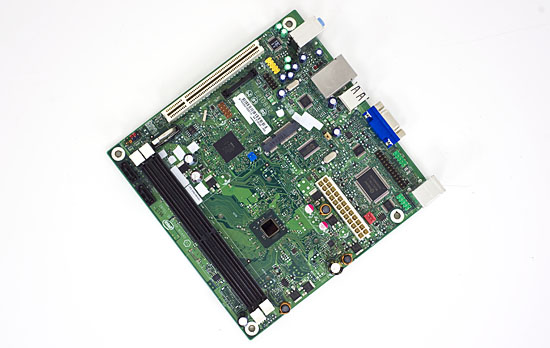
Unlike previous desktop Atom motherboards, the D510MO(B) is entirely passively cooled. Here Intel is benefitting from the lower power characteristics of the Pine Trial platform, showoffs. You get a single large heatsink covering the Pineview Atom CPU, while the tiny NM10 sits naked outside.
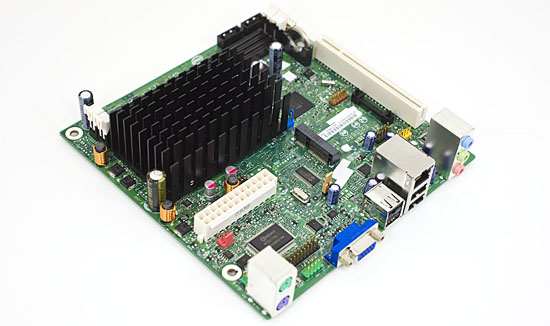
Intel's Pine Trail board with heatsink
Another welcome change is the inclusion of two DIMM slots, despite Pineview only offering a single 64-bit DDR2 memory channel. You get two SATA ports as well.
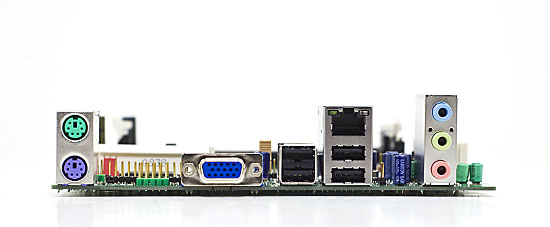
Flip around to the rear of the board and the I/O panel is devoid of any excitement. Four USB ports, Ethernet, PS/2 keyboard/mouse, three 1/8” audio jacks and a VGA output are all you get. Granted the board only costs $75 new, but would it have killed Intel to include DVI or HDMI out? Let’s advance the industry folks, even at the low end.
I suspect that it’s more of a ploy from Intel to characterize Pine Trail as an entry level machine and not something you go around plugging into HDTVs, after all it can’t decode 1080p H.264 video. Leave those sorts of things to Ions.
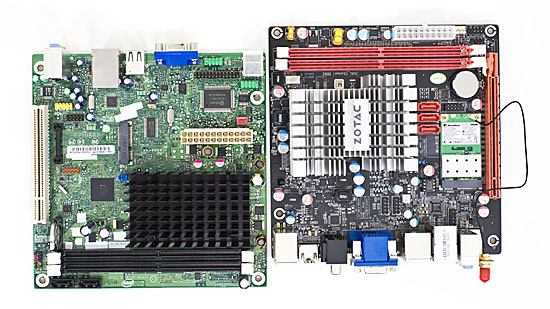
Intel's Pine Trail desktop board (left) vs. Zotac's latest Ion board (right)
Intel stuck the D510MO(B) in a mini-ITX chassis equipped with its own external DC power supply to demonstrate its usefulness as a complete system. While not quite as sexy as the latest Ion platforms, it shows you exactly what you can do with one of these motherboards.
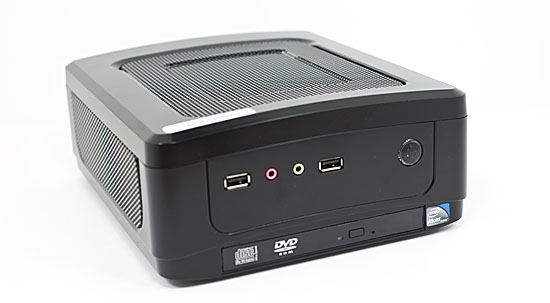
A fully passively cooled Pine Trail mini-ITX system
If you have a truly archaic desktop or want to add a third, fourth, fifth or fileserver PC to your network, grab one of these motherboards and using some relatively old/spare hardware you can build a functional machine. That’s the goal and in that capacity it works quite well. The cheapest Ion motherboards will run you over $110 and even then, in general usage tasks, they are actually slower. It’s only if you’re building a HTPC that Pine Trail disappoints, for a desktop or file server, you’re better off with Intel.











41 Comments
View All Comments
Ghandalf - Monday, December 21, 2009 - link
Hi,good article!
What power-supply did you use for your tests? The idle consumption of the new d510 looks too high for me!
blackbrrd - Monday, December 21, 2009 - link
This really doesn't look very impressive, looks like we have to wait for 32nm to make the GPU usable as noted in the article...Ghandalf - Monday, December 21, 2009 - link
Hi,good article!
What power-supply did you use for your tests? The idle consumption of the new d510 looks too high for me!
dgz - Monday, December 21, 2009 - link
I am tired of Intel forcing crap products on consumers, while touting the great benefits. Clearly there is no benefit for the consumers. Not to a single one as the IGP is barely enough for Minesweeper.Although I am very disappointed with nVidia these days, their offerings are much better on the mobile segments - both phones and nettops.
zdzichu - Monday, December 21, 2009 - link
Best feature of this platform is getting back to known, supported GPU. Intel damaged its reputation with Paulsbo, now there a chance to get back to supported graphics chipset, with proper Open Source drivers.ET - Monday, December 21, 2009 - link
The difference in numbers (950 vs. 3100) made me hope there'd be some improvement in the graphics, but it was my fault for not having done enough research. Turns out they're basically the same. I forgot it was the X3100 that had DX10 graphics, not the 3100 (how nice of Intel to use such clear naming convention).Still, in other respects this seems like an okay upgrade. A little better performance and lower power. I wonder if it will make the GMA 500 solutions go away.
AmdInside - Monday, December 21, 2009 - link
I'm a bit disappointed myself in Pinetrail platform. To me, it seems more or less a way to bring costs down for Intel while masking it as a performance bump to consumers. Unfortunately, my perfect netbook is an Atom dual core with an ION chipset on a 10" screen but it does not exist. There are 12" versions but then, it somewhat defeats the purpose of the netbook (portability and battery life). I wish a 10" version would come out. It would be the perfect companion video player. I could watch Hulu in bed, take to the gym and watch movies while on the treadmill, have it beside my main PC to stream sports programs while working, play hidef movies on my hard drive to a large HDTV, etc.. Hopefully someone will create a 10" Ion notebook in the near future.bnolsen - Saturday, December 26, 2009 - link
I don't know about playing movies to hidef but I watch hulu all the time with my current netbook, on linux even. I also watch 720p encoded content, but scaled to fullscreen.Go buy the lenevo for $194 and try it.
AznBoi36 - Monday, December 21, 2009 - link
I agree with all your points, which is why I have not yet jumped on the Atom bandwagon.dagamer34 - Monday, December 21, 2009 - link
It's pretty sad to see that Intel is muscling nVidia out of this market, when it's clear that a better product exists, and now we're getting a "new" product with worse performance across the board. Because if Flash isn't being hardware-accelerated, then that means that they CPU is doing more work, and whatever gains Pine Trail might have (i'm not convinced they're even worth writing an article over), it's negated by the exponential improvement in which Ion brings to the table.At first, I thought nVidia's CEO was blowing a bunch of hot air about Intel playing hardball, but it's pretty obvious that something is wrong with this picture here. If Microsoft got smacked down for bundling in 1998, I don't see how bundling the CPU and GPU into one chip and then locking other hardware vendors out with expensive contracts is any different. And what's worse, apparently the laws this time around allow the Federal government to not just look at Intel's past actions, but their effect on the future as well.